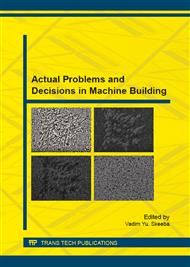[1]
A. G. Suslov, Quality of the surface layer of machine parts, Mashinostroenie Publishers, Moscow, (2000).
Google Scholar
[2]
Technological inheritance in machine engineering, in: A. M. Dal'skiy (Ed. ), Moscow Aviation Institute Publishers, Moscow, (2000).
Google Scholar
[3]
P. I. Yashcheritsyn, E. V. Ryzhov, V. I. Averchenkov, Technological inheritance in engineering, Science and technology, Moscow, (1977).
Google Scholar
[4]
Technology and tools in finishing and strengthening treatment of parts with surface plastic deformation: Handbook. In 2 Vol. V. 1. / A. G. Suslov, V. Yu. Blumenstein, R. V. Gurov, A. N. Isaev, L. G. Odintsov, V. V. Pleshakov, V. P. Fedorov, Yu. G. Shneyder, Mashinostroenie Publishers, Moscow, (2014).
Google Scholar
[5]
Yu. G. Shneyder, Technology of finishing with pressure: Handbook, Polytechnic, St. Petersburg, (1998).
Google Scholar
[6]
E. G. Odintsov, Strengthening and treatment of parts with surface plastic deformation: Handbook, Mashinostroenie Publishers, Moscow, (1987).
Google Scholar
[7]
Kh. M. Rakhimyanov, Y. S. Semenova, Surface geometry condition forecasting after ultrasonic surface plastic deformation of cilinders made of steel. Obrabotka metallov (tekhnologiya, oborudovanie, instrumenty). 52 (2011) 11–17.
Google Scholar
[8]
Kh. M. Rakhimyanov, Y. S. Semenova, Technological support of geometrical parameters of surface quality with ultrasonic plastic deformation. Obrabotka metallov (tekhnologiya, oborudovanie, instrumenty). 56 (2012) 33-36.
Google Scholar
[9]
Kh. M. Rakhimyanov, Yu. V. Nikitin, Iu. S. Semenova, The conditions of waviness forming at ultrasonic impact treatment of metals. Obrabotka metallov (tekhnologiya, oborudovanie, instrumenty). 54 (2012) 4-9.
Google Scholar
[10]
Yu. G. Kalpin, Yu. K. Filippov, N. N. Bezzubov, Technology, equipment, organization and economics of machine engineering, 10 (1988) 1-16.
Google Scholar
[11]
Yu. K. Filippov, Forging and Stamping Production. 2 (1999) 3-9.
Google Scholar
[12]
V. M. Smelyanskiy, Strengthening mechanics of machine part surface layer during surface plastic deformation, MASHMIR, Moscow, (1992).
Google Scholar
[13]
V. M. Smelyanskiy, Mechanics of strengthening with surface plastic deformation, Mashinostroenie Publishers, Moscow, (2002).
Google Scholar
[14]
V. Yu. Blumenstein, V. M. Smelyanskiy, Technological inheritance mechanics during the treatment and utilization of machine parts, Mashinostroenie Publishers, Moscow, (2007).
Google Scholar
[15]
V. A. Greshnikov, Yu. B. Drobot, Acoustic emission, Standards Publishers, Moscow, (1976).
Google Scholar
[16]
S. I. Buylo, A. S. Tripalin, Acoustic emission. Physical and mechanical aspects, State University, Rostov-on-Don, (1986).
Google Scholar
[17]
C. Beggan, M. Woulfe, P. Young and G. Byrne, Using Acoustic Emission to Predict Surface Quality, Int J Adv Manuf Technol. 15 (1999) 737-742.
DOI: 10.1007/s001700050126
Google Scholar
[18]
Slavko Dolinšek, Janez Kopač, Acoustic emission signals for tool wear identification, Wear. 225-229 (1999) 295-303.
DOI: 10.1016/s0043-1648(98)00363-9
Google Scholar
[19]
T. J. Chotard, A. Smith, N. Codet, M. De Baillencourt, D. Fargeot and C. Gault, New applications of acoustic emission technique for real-time monitoring of material processes, J. of Materials Science Letters. 21 (2002) 1261-1266.
DOI: 10.1023/a:1016559220138
Google Scholar
[20]
I. V. Miroshin, Technological support of hereditable quality parameters during strengthening treatment based on the selection of rational modes with the acoustic emission method: PhD thesis, Barnaul. (2008).
Google Scholar
[21]
A. I. Isaev, V. I. Gorbunova, Vestnik mashinostroeniya. 5 (1960) 57-59.
Google Scholar
[22]
S. G. Melikhov, Method of computing metal stress and strain state during cutting based on the plastic flow theory of non-homogeneous body: PhD thesis excerpt, Moscow. (1971).
Google Scholar
[23]
V. Yu. Blumenstein, A. A. Krechetov, The computer software # 2002611073 Russian Federation. (2002).
Google Scholar


